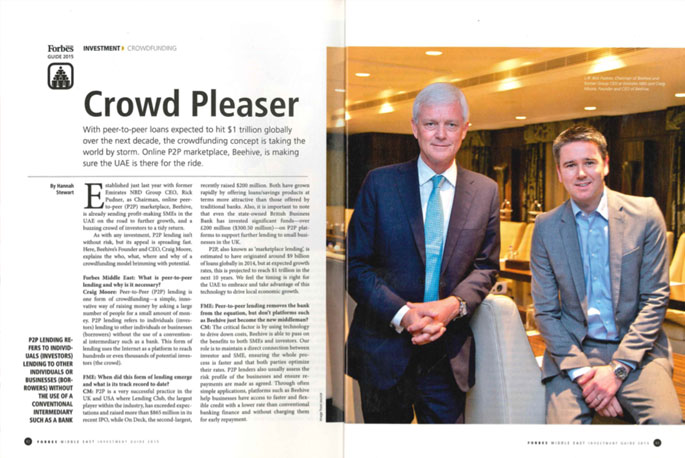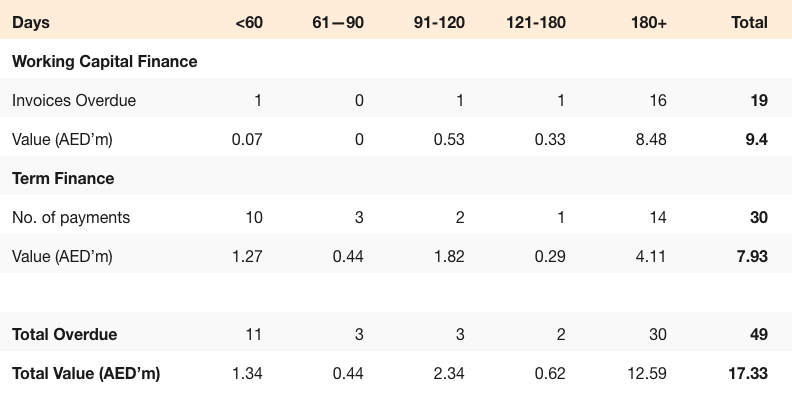With peer-to-peer loans expected to hit $1 trillion globally over the next decade, the crowdfunding concept is taking the world by storm. Online P2P marketplace, Beehive, is making sure the UAE is there for the ride.
Established just las year with former Emirates NBD Group CEO, Rick Pudner, as a Chairman, Beehive, is already sending profit –making SMEs in the UAE on the road to further growth, and a bussing crowd of investors to tidy return.
As with any investment, P2P lending isn’t without any risk, but its appeal is spreading fast. Here, Beehive’s Founder and CEO, Craig Moore, explains the who, what, where and why of a crowdfunding model brimming with potential.
- What is peer-to-peer lending and why is it necessary?
Peer-to-Peer (P2P) lending is one form of crowdfunding. Crowdfunding is a simple, innovative way of raising money by asking a large number of people for a small amount of money. P2P lending refers to individuals (investors) lending to other individuals or businesses (borrowers) without the use of a conventional intermediary such as a bank. P2P lending uses the Internet as a platform to reach hundreds or even thousands of potential investors (the crowd).
- When did this form of lending emerge and what is its track record to date?
P2P is a very successful practice in UK and USA where Lending Club, the largest player within the industry, has exceed expectations and raise more than $865 million in its recent IPO and On Deck the second largest recently raised $200 million. Both have grown rapidly by offering loans / savings products at terms more attractive than traditional banks. Also it is important to note that even the British Business Bank (part of the Government) has invested significant funds (over £200 million) on P2P platforms to support further lending to small businesses in UK. P2P, also known as ‘marketplace lending’, is estimated to originate around $9 billion of loans globally in 2014 but at expected growth rates this is projected to be $1 trillion in the next ten years. We feel the timing is right for the UAE to embrace and take advantage of this technology to drive local economic growth.
- Peer-to-peer lending removes the bank from the equation, but don’t platforms such as Beehive just become the new middleman? If so, what are the advantages?
The critical factor is by using technology to drive down costs Beehive is able to pass on the benefits to both SMEs and investors. Our role is to ensure a direct connection between investor and SME, ensure the whole process is faster and that both parties optimize their rates. We also assess the risk profile of the businesses and ensure repayments are made as agreed. Through a simple application the Beehive platform helps business to have access to faster and flexible credit with a lower rate than conventional banking finance and without charging them for early repayment.
- How does it differ from other types of crowd funding?
P2P lending refers to investors lending to businesses who make regular payments at a fixed interest rate. The interest rate is determined by a “reverse auction” meaning investors compete to lend. Investors monthly repayments and higher rates of return while managing their risk by diversifying their investments across many businesses. The Beehive model of unsecured lending means that SMEs can get access to cash that is not reliant on giving equity stakes in the business or taking out asset backed finance. It is a much quicker way to get funded – businesses get funded in less than 14 days on beehive.
Other models of crowdfunding include:
Equity-based crowdfunding is a model by which funders receive an interest in the form of equity in the venture they fund or, alternatively, revenue or profit-share arrangements. Seedrs and CrowdCube are leading examples of this model in the UK.
Reward-based crowdfunding allows funders to gain a non-financial benefit in return for financial contributions. Non-monetary rewards often take the form of a token of appreciation or the pre-purchasing of products or services. Kickstarter is probably the most famous in this model
Donation-based crowdfunding provides funders with a way to donate to causes that they want to support, with no expected compensation (i.e., philanthropic or sponsorship based incentive).
- According to the Beehive website, global peer-to-peer lending was estimated at $5 billion dollars up until the end of 2013. How about the Middle East? Are there any figures or statistics for the region?
There are very limited figures for this region at this point but with the USD$ 1 trillion forecast we would expect the Middle East to foster and support a sizeable market.. The growth of peer-to-peer lending is accelerating rapidly and its expansion into new markets is inevitable as economies, governments and regulators seek smarter solutions to SME financing.
- If I am a young professional looking to take my first steps into the world of investing, is peer-to-peer lending for me? If not, what kind of investor does it appeal to?
P2P is an alternative asset class investment and as such would make up no more than 3-5% of a diversified portfolio for any investor. It appeals to can appeal to a range of sophisticated investors, all the way up to institutional investors. As a risk adjusted investment P2P has performed well in western markets and many investors enjoy the fact that they are backing local businesses helping to drive employment and growth. We believe it can form a small part of a balanced investment portfolio for most, but if potential investors are unsure if P2P is right for them we recommend they speak to an independent financial advisor.
- How do companies such as Beehive assess the eligibility and credibility of the businesses listed?
We go through a very strict process before we accept any business on our platform. Businesses must be profitable, established for two years or more, have no adverse credit history and be a UAE based company.
Our proprietary credit model and process has been developed to ensure that all applications are rigorously reviewed and only the businesses deemed as creditworthy are listed on our marketplace. Successful applications are given a guide rating of either A, B or C (Excellent, Strong or Good) so that investors can make an informed choice as to the return they would like on any particular loan. Beehive is not available for startup or pre-profit businesses but established businesses (over 2 years) that are looking for expansion capital to fuel their growth.
- Similarly, with peer-to-peer lending conducted online, are there risks associated with removing face-to-face interaction? After all, many investment decisions are based on chemistry and relationships.
In the west so many successful business models have moved online because it is faster, more convenient and cheaper way for users to do business. In the UK P2P market over USD$4 billion of loans have been funded this way and much of this relies on credit assessment and risk algorithms.
The Beehive model in the UAE requires a face-to-face meeting with the business owner before a successful listing in addition to a full credit assessment. It is important that investors understand that risk does exist because even creditworthy businesses can default on their loan obligations – this is why it’s also important investors diversify across a number of loans.
- Aside from the obvious investment value, what are the costs involved in peer-to-peer lending, and conversely, what kind of returns can investors expect?
By using technology to connect parties, the costs of p2p are very transparent and significantly lower compared to the conventional banking financing. The investors are charged a very small fee on the repayments they receive from businesses. There are no “assets under management fees” or other hidden charges, typical of traditional investment funds or asset management companies
For businesses, besides the much lower borrowing rates, p2p also simplifies and reduces the processing fees. The fees are charged to businesses only once their finance request has been funded and approved, and the fees get deducted automatically from the total finance amount. No other fees are charged to businesses, not even if they decide to repay their financing early.
What many investors don’t realize is that bank unsecured lending rates in the UAE range from about 16% to 24% APR which means that there is a good chance that investors can lend money at say 12% to 14%. It’s important to note that because businesses pay a weighted average rate you can have investor 1 receiving 9% interest and investor 2 receiving 17% but the business is paying 13% blended.
- What are the challenges of introducing and maintaining peer-to-peer lending in the Middle East?
P2P is a new model in this region but the opportunity is significant as the International Finance Corporation (IFC) estimates the current SME funding gap in the MENA region to be at least USD$260 billion. This considerable gap between the demand and supply of capital is driving a critical need for alternative finance solutions to fuel growth in this critically underserved sector of the economy. The challenges will be educating the market as to the benefits and transparency to drive volume adoption as well as providing comfort to regulators that P2P companies have the necessary investor protection measures in place.
- What kinds of businesses and investors have been involved with Beehive to date?
A wide spectrum of business sectors, we have funded a manufacturer of Disposable Plastic, HR consultant, coffee supplier, a pet shop…etc. Our investor base includes male and female investors from many different nationalities and across a wide age ranges. Some investors bid with small amounts and other have bid significant sums of money across the platform
- Can you share any local success stories of peer-to-peer lending that might inspire entrepreneurs and investors across the region?
We’ve had a fantastic response so far with over AED 2.52m in business funding already completed and more in the pipeline after the first few weeks. Over 60065 investors have registered and we’re seeing investor sign ups on a daily basis, so SMEs interested in registering on Beehive can be confident that investor demand is high.
“Beehive shared a new concept on bridging the gap between investors and the beneficiaries at a rate which becomes a win-win for both – and at cheaper rates than the bank. Thus we choose Beehive.
The Beehive process was very transparent with completely clear guidelines, making it much more robust, quicker and cheaper than local conventional banks.
We are using the loan to settle a more expensive loan thus reducing our cost of finance.
We were able to make projections due to a clear timeline, which would have been more difficult had we used more traditional methods of financing.
Beehive is bringing an innovative lower cost of finance option while maintaining a high quality of scrutiny and checks”. Said Vishaal Shah, CEO, Panache International.
- In your opinion, what is the future of peer-to-peer lending in the Middle East, and how significant could it be to the region’s economies?
There is huge potential in this market and a real focus on innovation. With the prospect of Expo 2020 in addition to other regional initiatives we feel there’s a real spirit of optimism amongst SMEs and by bringing investors and businesses together we’re really excited that Beehive can help foster mutually beneficial partnerships for growth across the UAE community.
Source: Forbes Middle East




